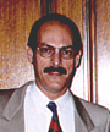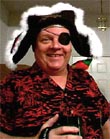|
|
 
|
|
Author
|
Topic: Ed DiGuilio Passes away
|
|
|
|
|
|
|
|
|
John Pytlak
Film God

Posts: 9987
From: Rochester, NY 14650-1922
Registered: Jan 2000
|
 posted 07-22-2004 03:36 PM
posted 07-22-2004 03:36 PM





More links:
http://www.mte.com/nysmpte/digiulio/digiulio.htm
quote:
One of the brightest lights in our industry has been dimmed. Ed DiGiulio passed away on Friday, June 4th.
In 1968 Ed DiGiulio founded Cinema Products after having worked as VP of Engineering at Mitchell camera, where he developed the first BNC reflex cameras. At CP, Ed developed crystal-control motors for film cameras which eliminated the need for a sync cable between the camera and the sound recorder. These accomplishments earned Academy-citations for technical achievement.
In the early-to-mid 1970's the company manufactured and sold thousands on CP16 & CP-16R sound sync cameras for news, documentary and some production work. The camera was the standard for news gathering until it was displaced by the use of ENG cameras.
While helming Cinema Products, DiGiulio also developed the Steadicam, for which he, along with inventor Garrett Brown and Cinema Products' engineering staff, won an Oscar in 1978.
During the later stages of his career, DiGiulio developed the Showscan 65mm, 60fps motion picture camera, the Key Code time code reader and most recently had been working with Dalsa as a consultant on their Orgin digital cinema cameras.
Edmund M. DiGiulio was a Fellow of the Society of Motion Picture and Television Engineers (SMPTE), a Fellow of the British Kinematograph Sound and Television Society (BKSTS), a long-time member, and five-time chairman, of the Academy of Motion Picture Arts and Sciences Scientific and Technical Committee and an associate member of the American Society of Cinematographers (ASC). In 2001, Ed received the Gordon E Sawyer Academy Award for recognition by the Academy Technical Committee of a lifetime of Technical Achievement.
http://www.visual-memory.co.uk/sk/ac/len/page1.htm
quote:
Two Special Lenses for "Barry Lyndon" by Ed DiGiulio (President, Cinema Products Corp.)
From: American Cinematographer:
How the stringent demands of a purist-perfectionist film-maker led to the development of two valuable new cinematographic tools.
My first contact with Stanley Kubrick was when he was referred to me by our mutual friend, Haskell Wexier, ASC, during Kubrick's preparation for "A CLOCKWORK ORANGE". Haskell indicated to him that I and my company were very responsive to the demanding needs of professional filmmakers, especially when it came to coming up with unique solutions to difficult probems...
My relationship with Stanley Kubrick has been one of the most unusual, yet intellectually stimulating, that I have ever known. We have spent countless hours in telephone conversations, and written literally hundreds of letters and telexes back and forth. Yet I have never met the man! I felt sure I would while in London attending the Film '73 exhibition with my wife, Lou. We were escorted to his combination home-and-office by his executive producer, Jan Harlan. But when we arrived, Kubrick was out scouting locations for "BARRY LYNDON" and expressed his regrets at not having been there to meet us. We were, however, very graciously entertained by his lovely wife Christiane, who is an accomplished and recognized artist in her own right.
This minor frustration aside, it has been an exciting and stimulating experience working with a man of Kubrick's consummate skills and talents on his recent film projects. He currently has me investigating another camera/optical scheme he has in mind which I think I should keep confidential until he has had a chance to use it. Undoubtedly, it will be used on his next film project (a project which I look forward to with a mixture of trepidation and excitement).
Our company motto is: "Technology in the Service of Creativity." I cannot think of a more fitting example of our motto at work than the modest role my company and I played in the making of "BARRY LYNDON".
http://www.theasc.com/magazine/oct99/violence/pg1.htm
quote:
Haskell Wexler, ASC told Kubrick that Ed DiGiulio, president of Cinema Products Corporation in Los Angeles, was responsive to the demanding requirements of filmmakers, prompting the director to call DiGiulio about his technical needs for Clockwork. After their discussion, DiGiulio purchased a standard Mitchell BNC for Kubrick, which Cinema Products overhauled. DiGiulio also supplied a joystick control for smooth operation of zoom lenses, and a BNC crystal motor. Interestingly, the BNC was not modified for reflex viewing, allowing Kubrick tremendous flexibility in the use of special lenses.
For this film, Kubrick envisioned shots that would utilize extremely long, continuous zooms. "Stanley started chatting with me about getting a 20:1 zoom lens, and I said, ’We could do it,’" DiGiulio has reported. He explained to Kubrick that his company could take an Angenieux 16mm 20:1 zoom and put a 2x extender behind it so that it would cover the 35mm format. However, there would be a loss of two stops of light. "The next day I get a telex that’s a yard long in which he explains to me that the 35mm format he’s shooting in is 1.66:1," DiGiulio remembered.
| IP: Logged
|
|
|
|
|
|
|
|
|
|
|
|
|
|
|
|
All times are Central (GMT -6:00)
|
|
Powered by Infopop Corporation
UBB.classicTM
6.3.1.2
The Film-Tech Forums are designed for various members related to the cinema industry to express their opinions, viewpoints and testimonials on various products, services and events based upon speculation, personal knowledge and factual information through use, therefore all views represented here allow no liability upon the publishers of this web site and the owners of said views assume no liability for any ill will resulting from these postings. The posts made here are for educational as well as entertainment purposes and as such anyone viewing this portion of the website must accept these views as statements of the author of that opinion
and agrees to release the authors from any and all liability.
|

 Home
Home
 Products
Products
 Store
Store
 Forum
Forum
 Warehouse
Warehouse
 Contact Us
Contact Us




 Printer-friendly view of this topic
Printer-friendly view of this topic







![[thumbsup]](graemlins/thumbsup.gif)








